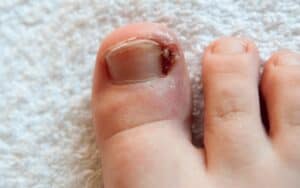Introduction
Welcome to our comprehensive guide on the pros and cons of laser treatment for toenail fungus and the revolutionary laser treatment option. If you or someone you know is struggling with toenail fungus, this article is a must-read.

Dementia Discovery That is Leaving Doctors Speechless (Try This Tonight)
Better than Morphine For Joint Pain… Yet Safer Than Aspirin?
Retire With Freedom. Start Earning Extra Cash Today.
We’ll delve into the causes, traditional treatment options, and the emergence of laser therapy, providing valuable insights for making informed decisions about your health.
What is Toenail Fungus?
Toenail fungus, also known as onychomycosis, is a common condition caused by dermatophytes, yeast, or molds. It affects the toenails, leading to discoloration, thickening, and crumbling.
This condition can cause discomfort and affect the appearance of the nails, impacting self-confidence and overall well-being.
Causes of Toenail Fungus

Toenail fungus, also known as onychomycosis, can be caused by various factors. Understanding these causes can help in preventing and managing toenail fungus effectively. Some of the common causes of toenail fungus include:
- Poor Foot Hygiene: Not keeping the feet clean and dry can create an ideal environment for fungus to thrive.
- Humid Environments: Moist and warm environments, such as sweaty socks and shoes, provide a breeding ground for toenail fungus.
- Tight-Fitting Shoes: Wearing shoes that are too tight can lead to repetitive trauma to the toenails, making them more susceptible to fungal infections.
- Walking Barefoot in Public Places: Public areas like swimming pools, locker rooms, and communal showers may harbor fungi that can infect the toenails.
- Weakened Immune Systems: Individuals with weakened immune systems, such as those with diabetes or HIV, are at a higher risk of developing toenail fungus.
- Age: As people age, the blood circulation in the feet may decrease, leading to a higher risk of fungal infections.
- Genetics: A family history of toenail fungus can increase the likelihood of developing the condition.
- Peripheral Arterial Disease: This condition reduces blood flow to the feet, making it easier for fungal infections to occur.
By being aware of these causes, individuals can take proactive measures to lower their risk of toenail fungus and maintain optimal foot health.
Traditional Treatment Options for Toenail Fungus
When it comes to dealing with toenail fungus, there are several traditional treatment options available. These methods have been used for years and have shown varying degrees of effectiveness in managing toenail fungus. Here are some of the traditional treatment options:
- Topical Antifungal Creams: These creams are applied directly to the affected nails and surrounding skin. They work by targeting the fungal infection and inhibiting its growth. While these creams can be effective, they often require consistent and long-term application to see results. It’s important to follow the prescribed application guidelines to maximize their effectiveness.
- Oral Medications: In some cases, oral antifungal medications may be prescribed to combat toenail fungus. These medications work from within the body to attack the fungal infection. However, they may come with potential side effects and require regular monitoring by a healthcare professional to ensure their safe use.
- Surgical Removal: For severe or persistent cases of toenail fungus, surgical removal of the affected nail may be considered. This procedure involves removing the infected nail tissue to allow for the growth of a new, healthy nail. While surgical removal can effectively eliminate the fungal infection, it is considered a last resort due to the invasiveness of the procedure and the potential for complications.
The Rise of Laser Treatment for Toenail Fungus
With advancements in medical technology, laser treatment has emerged as a promising alternative for addressing toenail fungus. This non-invasive procedure targets the affected area with focused laser energy, effectively eliminating the fungal infection. The rise of laser therapy offers a safer, more efficient approach to combating toenail fungus.
How Laser Treatment Works
Laser treatment for toenail fungus utilizes concentrated light energy to penetrate the nail and eradicate the fungal infection. This targeted approach selectively destroys the fungus while preserving the surrounding healthy tissue. The procedure is relatively quick and typically entails minimal discomfort, offering a convenient solution for addressing toenail fungus.
Pros of Laser Treatment for Toenail Fungus
Laser treatment for toenail fungus offers several advantages, including minimal side effects, no downtime, and high success rates. Unlike oral medications, laser therapy poses no risk of liver damage and does not require ongoing medication usage, making it a favorable option for individuals with toenail fungus.
Cons of Laser Treatment for Toenail Fungus
Cons of Laser Treatment for Toenail Fungus
- Laser treatment for toenail fungus may require multiple sessions for optimal results.
- The cost of laser therapy can be higher than traditional treatments.
- Some individuals may experience mild discomfort during the procedure.
While laser treatment for toenail fungus is an effective option, it’s important to consider the following additional points:
- Effectiveness: Laser treatment has shown varied levels of effectiveness in treating toenail fungus. While some individuals experience complete resolution of the infection after treatment, others may only see partial improvement.
- Recovery Time: The recovery time after laser treatment can vary depending on the individual’s overall health and the severity of the toenail fungus. It’s important to understand the expected recovery period and any post-treatment care that may be necessary.
- Risk of Reoccurrence: There is a risk of toenail fungus reoccurring after laser treatment. It’s essential to discuss preventative measures with the healthcare provider to reduce the chances of the infection returning.
Risk Factors and Considerations
Individuals considering laser treatment for toenail fungus should be aware of the following risk factors and considerations:
- Medical History: It’s crucial to discuss any existing health conditions, such as diabetes, circulatory problems, or immunodeficiency disorders, with the healthcare provider. These conditions may affect the suitability of laser treatment.
- Allergies and Sensitivities: Patients should inform the healthcare provider about any known allergies, especially to medications or topical treatments, as this may impact the choice of laser therapy.
- Medications: The healthcare provider should be informed about any medications being taken, including over-the-counter drugs and supplements, to ensure they do not interfere with the laser treatment.
- Expectations and Realistic Goals: Understanding the expected outcomes and setting realistic goals for the treatment is important for patient satisfaction and informed decision-making.
- Comprehensive Consultation: A thorough consultation with the healthcare provider should cover the benefits, risks, and potential outcomes of laser treatment, allowing the patient to make an informed decision.
Additionally, individuals should be aware that laser treatment is not suitable for everyone, and alternate treatment options should be explored in certain cases. Patients are encouraged to ask questions and seek clarification on any concerns they may have before proceeding with laser therapy.
Cost of Laser Treatment
When considering the cost of laser treatment for toenail fungus, it’s important to take into account several factors that contribute to the overall expenses. Understanding the cost structure of laser therapy can help individuals make informed decisions about this treatment option.
Here are some key points to consider in relation to the cost of laser treatment:
- Number of Sessions: The total cost of laser treatment can vary based on the number of sessions required to effectively target the toenail fungus. In some cases, multiple sessions may be necessary to achieve optimal results.
- Healthcare Provider’s Fees: Different healthcare providers may have varying fee structures for laser treatment. It’s advisable to inquire about the specific fees involved and what services are covered within the overall cost.
- Comparative Cost Analysis: While laser therapy may initially entail a higher cost compared to traditional treatments, it’s important for individuals to weigh the long-term benefits and the potential cost savings. When considering the effectiveness and minimal invasiveness of laser treatment, many individuals find it to be a worthwhile investment in the management of toenail fungus.
Aftercare and Recovery
Aftercare and Recovery
- Following laser treatment for toenail fungus, individuals are typically advised on aftercare practices to promote optimal recovery.
- This may include:
- Maintaining proper foot hygiene
- Wearing breathable footwear
- Applying prescribed topical treatments
- Regular follow-up appointments with the healthcare provider are also recommended to monitor the healing process.
After laser treatment for toenail fungus, it is important to take measures that support the healing process and prevent recurrence of the infection. Proper aftercare plays a crucial role in ensuring the success of the treatment and the long-term health of the toenails.
The Pros and Cons of Laser Treatment for Toenail Fungus – Conclusion
In conclusion, laser treatment for toenail fungus presents a cutting-edge approach to combatting this common condition. With its minimal side effects, high success rates, and non-invasive nature, laser therapy offers an appealing solution for individuals seeking effective and convenient toenail fungus treatment.
By weighing the pros and cons of laser treatment and considering individual circumstances, informed decisions can be made to address toenail fungus effectively.






